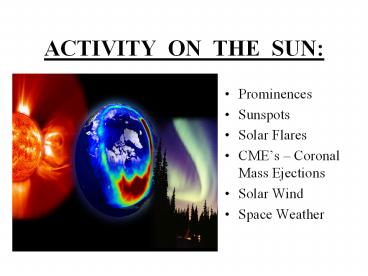ACTIVITY ON THE SUN: PowerPoint PPT Presentation
1 / 21
Title: ACTIVITY ON THE SUN:
1
ACTIVITY ON THE SUN
- Prominences
- Sunspots
- Solar Flares
- CMEs Coronal Mass Ejections
- Solar Wind
- Space Weather
2
Prominences
- Prominences are clouds of gas forming above
sunspots that follow the magnetic field line
loops. So-called quietones form in the corona.
(about 40,000 kilometers above the surface) Quiet
prominences last several days to several weeks.
Surge prominences lasting up to a few hours
shoot gas up to 300,000 kilometers above the
photosphere.
3
Prominence Image
4
Sunspots
- Sunspots are areas on the sun with strong
magnetic fields. The solar magnetic field is
responsible for the sunspot cycle. Alternating
every 11 years between solar maximum (11 years)
and solar minimum (11years) making one entire
cycle 22 years long. - Most sunspots form in groups around the solar
equator.
5
Sunspots
6
Sunspots
- Galileo discovered that the Sun's surface is
sprinkled with small dark regions called
sunspots. - Sunspots are cooler regions on the photosphere.
Since they are 1000--1500 K cooler than the rest
of the photosphere, they do not emit as much
light and appear darker. - They can last a few days to a few months.
7
Sunspots
- Galileo used the longer-lasting sunspots to map
the rotation patterns of the Sun. Because the Sun
is gaseous, not all parts of it rotate at the the
same rate. - The solar equator rotates once every 25 days,
while regions at 30 above and below the equator
take 26.5 days to rotate and regions at 60 from
the equator take up to 30 days to rotate.
8
Solar Flares
- Solar Flare eruptions are larger than
prominences. Solar Flares will last only a few
minutes to a few hours. - A lot of ionized material is ejected in a flare.
Unlike the material in prominences, the solar
flare material moves with enough energy to escape
the Sun's gravity. - When this burst of ions reaches the Earth, it
interferes with radio communication.
9
Solar Flares
- Sometimes a solar flare will cause voltage
pulses or surges in power and telephone lines.
Brownouts or blackouts may result. - Humans traveling outside the protection of the
Earth's magnetic field will need to have
shielding from the powerful ions in a flare.
10
CMEs Coronal Mass Ejections
- CMEs are much like Solar Flares
- CMEs and Solar Flares are the biggest
explosions in our solar system
11
CMEs Continued
- CMEs and Solar Flares have the power of about
100 billion Hydrogen Bombs! - Some CME speeds can be 2 million miles a second
faster than the solar wind. - And releases 220 billion pounds of material from
the sun.
12
CME video
13
Solar Wind
- Solar Wind
14
Solar Wind Continued
- Solar Wind is the cause of space weather.
- Solar Wind is charged particles, such as
electrons and protons, called plasma, coming out
of the Sun in all directions at very high speeds
-- an average of about 400 km/sec, almost a
million mph!.
15
Solar Wind Continued
- Solar Wind is responsible for the anti-sunward
tails of comets and the shape of the magnetic
fields around the planets. - Particles from the solar wind can get trapped
near the north or south poles of planetary
magnetic fields causing auroras.
16
Aurora Borealis Northern Lights
17
Aurora Australis South Pole
18
Space Weather
- Major solar activity is a very serious concern
in space flight. - Communications may be disrupted. Large solar
disturbances heat the upper atmosphere, causing
it to expand and create increased drag on
spacecraft in low orbits, shortening their
orbital lifetime. - Spacecraft could potentially tumble and burn up
in the atmosphere. - Also, radiation exposure to astronauts is also
seriously increased and of high risk!
19
Space Weather Continued
- Radiation sickness can result when humans are
outside the protective magnetosphere of the
Earth, as in missions to the moon and to Mars. - NASA Monitors astronaut's exposure to radiation
- High-energy solar protons can produce increased
radiation in the atmosphere at altitudes where
supersonic aircraft fly. This is especially true
for flights over the north and south magnetic
poles, areas unprotected by the Earth's magnetic
field, where the radiation has direct access to
the atmosphere.
20
Space Weather
- To reduce the risk to aircraft, crews and
passengers, routine forecasts and alerts are sent
through the Federal Aviation Administration so
that a flight in potential danger can consider
what course of action to take to minimize
radiation exposure. - The National Oceanic and Atmospheric
Administration (NOAA) Space Environment Center
(SEC) forecasts high-speed solar wind
advisories.
21
REVIEW - Solar Activity

